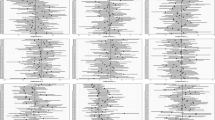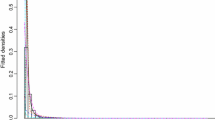Abstract
In this paper we deal with maximum likelihood estimation (MLE) of the parameters of a Pareto mixture. Standard MLE procedures are difficult to apply in this setup, because the distributions of the observations do not have common support. We study the properties of the estimators under different hypotheses; in particular, we show that, when all the parameters are unknown, the estimators can be found maximizing the profile likelihood function. Then we turn to the computational aspects of the problem, and develop three alternative procedures: an EM-type algorithm, a Simulated Annealing and an algorithm based on Cross-Entropy minimization. The work is motivated by an application in the operational risk measurement field: we fit a Pareto mixture to operational losses recorded by a bank in two different business lines. Under the assumption that each population follows a Pareto distribution, the appropriate model is a mixture of Pareto distributions where all the parameters have to be estimated.
Similar content being viewed by others
References
Ahmad K (1988) Identifiability of finite mixtures using a new transform. Ann Inst Stat Math 40: 261–265
Atienza N, Garcia-Heras J, Munoz-Pichardo J, Villa R (2007) On the consistency of MLE in finite mixture models of exponential families. J Stat Plan Inference 137: 496–505
Brooks S, Morgan B (1995) Optimization using simulated annealing. Statistician 44: 241–257
Casella G, Robert C (2004) Monte Carlo statistical methods, 2nd edn. Springer, NewYork
Dempster N, Laird N, Rubin D (1977) Maximum likelihood from incomplete data via the EM algorithm (with discussion). J R Stat Soc B 39: 1–38
Geman S, Geman D (1984) Stochastic relaxation, Gibbs distributions, and the Bayesian restoration of images. IEEE Trans Pattern Anal Mach Intell 6: 721–741
Ingrassia S (1992) A comparison between the simulated annealing and the EM algorithms in normal mixture decompositions. Stat Comput 2: 203–211
Johnson D, Aragon C, McGeoch L, Schevon C (1989) Optimization by simulated annealing: an experimental evaluation, part I, graph partitioning. Oper Res 37: 865–892
Kirkpatrick S, Gelatt C, Vecchi M (1983) Optimization by simulated annealing. Science 220: 671–680
Kleiber C., Kotz S (2003) Statistical size distributions in economics and actuarial sciences. Wiley, New York
Kroese D, Porotsky S, Rubinstein R (2006) The cross-entropy method for continuous multi-extremal optimization. Methodol Comput Appl Probab 8: 383–407
Lehmann EL, Casella G (1998) Theory of point estimation, 2nd edn. Springer, NewYork
Little R, Rubin D (1987) Statistical analysis with missing data. Wiley, Hoboken
McLachlan G, Krishnan T (1996) The EM algorithm and extensions. Wiley, Hoboken
McLachlan G, Peel D (2000) Finite mixture models. Wiley, NewYork
McNeil A, Frey R, Embrechts P (2005) Quantitative risk management: concepts, techniques, tools. Princeton University Press, Princeton
Metropolis N, Rosenbluth A, Rosenbluth N, Teller A, Teller E (1953) Equations of state calculations by fast computing machines. J Chem Phys 21: 1087–1092
Nadarajah S (2006) Information matrices for Laplace and Pareto mixtures. Comput Stat Data Anal 50: 950–966
Pareto V (1895) La legge della domanda. Giornale degli Economisti 10: 59–68
Pearson K (1894) Contribution to the mathematical theory of evolution. Philos Trans R Soc A 185: 71–110
Pincus M (1968) A closed form solution of certain programming problems. Oper Res 16: 690–694
Pincus M (1970) A Monte Carlo method for the approximate solution of certain types of constrained optimization problems. Oper Res 18: 1225–1228
R Development Core Team (2011) R: a language and environment for statistical computing. R Foundation for statistical computing, Vienna, Austria. ISBN 3-900051-07-0
Redner R, Walker H (1984) Mixture densities, maximum likelihood and the EM algorithm. SIAM Rev 26: 195–239
Rubinstein R (1997) Optimization of computer simulation models with rare events. Eur J Oper Res 99: 89–112
Rubinstein R (1999) The cross-entropy method for combinatorial and continuous optimization. Methodol Comput Appl Probab 2: 127–190
Rubinstein R, Kroese D (2004) The cross-entropy method. Springer, NewYork
Sankaran P, Nair MT (2005) On a finite mixture of Pareto distributions. Calcutta Stat Assoc Bull 57: 67–83
Severini T (2000) Likelihood methods in statistics. Oxford University Press, Oxford
Titterington D, Smith A, Makov U (1985) Statistical analysis of finite mixture distributions. Wiley, NewYork
Author information
Authors and Affiliations
Corresponding author
Rights and permissions
About this article
Cite this article
Bee, M., Benedetti, R. & Espa, G. On maximum likelihood estimation of a Pareto mixture. Comput Stat 28, 161–178 (2013). https://doi.org/10.1007/s00180-011-0291-z
Received:
Accepted:
Published:
Issue Date:
DOI: https://doi.org/10.1007/s00180-011-0291-z




